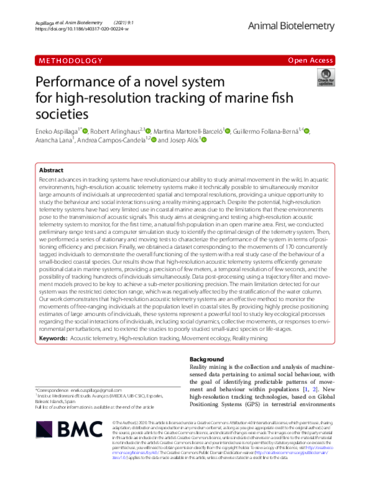Recent advances in tracking systems have revolutionized our ability to study animal movement in the wild. In aquatic environments, high-resolution acoustic telemetry systems make it technically possible to simultaneously monitor large amounts of individuals at unprecedented spatial and temporal resolutions, providing a unique opportunity to study the behaviour and social interactions using a reality mining approach. Despite the potential, high-resolution telemetry systems have had very limited use in coastal marine areas due to the limitations that these environments pose to the transmission of acoustic signals. This study aims at designing and testing a high-resolution acoustic telemetry system to monitor, for the first time, a natural fish population in an open marine area. First, we conducted preliminary range tests and a computer simulation study to identify the optimal design of the telemetry system. Then, we performed a series of stationary and moving tests to characterize the performance of the system in terms of positioning efficiency and precision. Finally, we obtained a dataset corresponding to the movements of 170 concurrently tagged individuals to demonstrate the overall functioning of the system with a real study case of the behaviour of a small-bodied coastal species. Our results show that high-resolution acoustic telemetry systems efficiently generate positional data in marine systems, providing a precision of few meters, a temporal resolution of few seconds, and the possibility of tracking hundreds of individuals simultaneously. Data post-processing using a trajectory filter and movement models proved to be key to achieve a sub-meter positioning precision. The main limitation detected for our system was the restricted detection range, which was negatively affected by the stratification of the water column. Our work demonstrates that high-resolution acoustic telemetry systems are an effective method to monitor the movements of free-ranging individuals at the population level in coastal sites. By providing highly precise positioning estimates of large amounts of individuals, these systems represent a powerful tool to study key ecological processes regarding the social interactions of individuals, including social dynamics, collective movements, or responses to environmental perturbations, and to extend the studies to poorly studied small-sized species or life-stages.
Performance of a novel system for high‑resolution tracking of marine fish societies
Rezensierter Artikel

Aspillaga, E., Arlinghaus, R., Martorell‑Barceló, M., Follana‑Berná, G., Lana, A., Campos‑Candela, A., Alós, J. (2021). Performance of a novel system for high‑resolution tracking of marine fish societies. Animal Biotelemetry, 9, 1-14
Veröffentlicht
: 2021
Erschienen in
: Animal Biotelemetry, 9, 1-14
